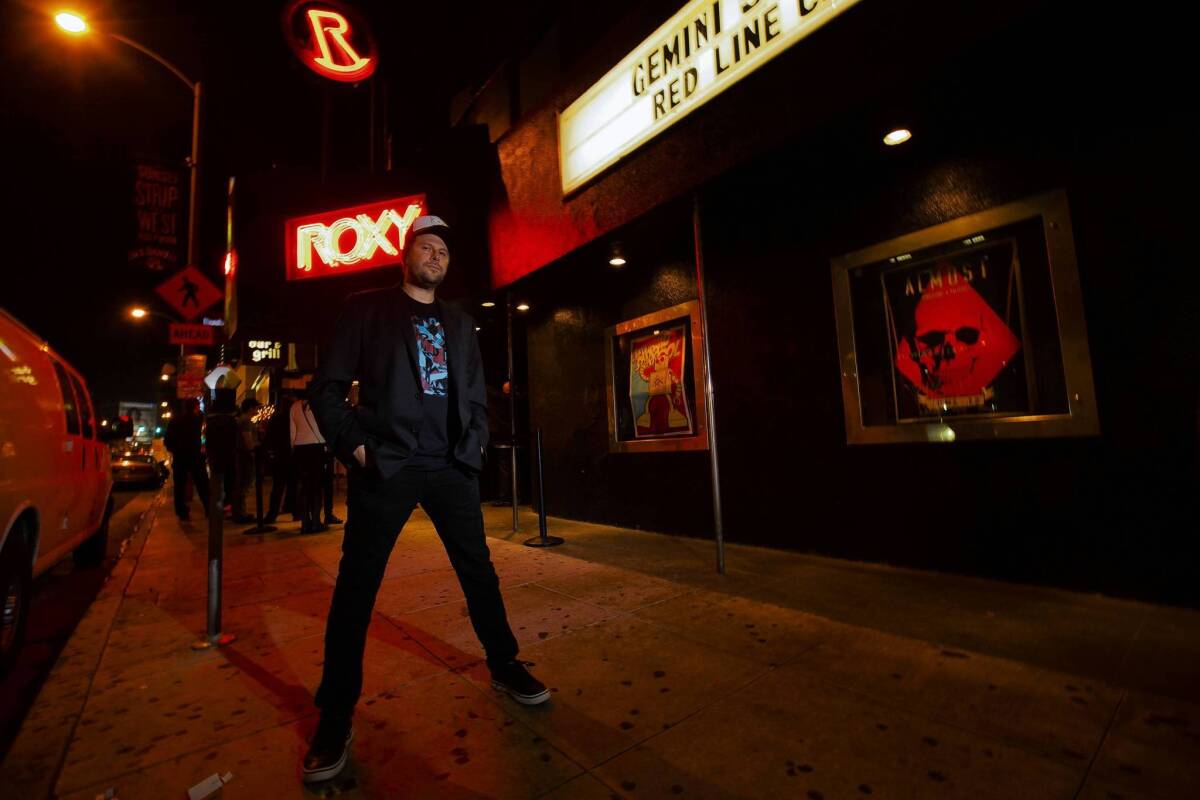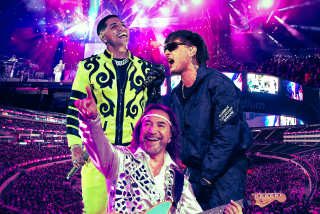Music and identity crisis on the Sunset Strip

This post has been corrected, please see below for details.
In March, the Sunset Strip music venue the Key Club announced that it was closing for good. Few local music fans were especially surprised.
The venue had operated in various guises since the â60s â first as Gazzarriâs, where it hosted such rock ânâ roll royalty as the Doors, Guns Nâ Roses and Van Halen â and as the Key Club since 1998. It closed briefly in 2009, but 2013 was to be the final curtain for the clubâs monthly slate of heavy metal, hip-hop and stuffed local bills where bands sometimes had to prepay for blocks of tickets. The owners were working hard to turn it around, but âmy pockets just werenât deep enough to maintain a club that size,â said Key Club operations manager Ian Shepp. âThe Strip will be fine, though. Itâs just going through a cycle.â
For one of Americaâs most storied miles for rock music, that cycle is a part of an ongoing identity crisis. That the Sunset Strip is inseparable from L.A.âs music history is both its biggest blessing and its biggest albatross. As the economy improves and both fan and investment money circulate again, Sunset Boulevardâs venues and the Sunset Strip Music Festival are figuring out a balance between the Stripâs place in L.A. music lore and knowing that a rock ânâ roll museum piece wonât get young fans in the door.
PHOTOS: The Sunset Strip Music Festival 2012
Within the recent tumult, there might be a way forward for a neighborhood beating back stereotypes of â80s survivors with complexions as leathery as their pants.
On the one hand, legacy-rich rock spaces such as the Key Club and the Cat Club have closed in recent months, while others such as the Whisky a Go Go and the Viper Room have for years played distant catch-up to Echo Park and Silver Lake clubs such as the Echo, the Satellite and the Bootleg Bar.
On the other hand, âSunset Stripâ still means music to Angelenos â and generations of rock fans everywhere. Last year, the Sunset Strip Music Festival drew 15,000 fans to see such headliners as goth-rocker Marilyn Manson and EDM-punker Steve Aoki. This yearâs fest, on Aug. 3, will feature L.A. rockers Linkin Park. The Roxy, under the leadership of music-biz scion Nic Adler, has become a social-media juggernaut with nearly 500,000 Facebook fans and has booked recent pace-setting nights with Lianne La Havas, Gary Clark Jr. and Frank Turner, along with the music-laden Vegan Beer Fest. Even the Key Club stands to be reborn after being bought out by the New York-via-Las Vegas club 1OAK, which will soon renovate it into a gilded space for hip-hop artists and DJs.
So whatâs the future for music on the Strip â competing for todayâs cool kids, cashing in on its history or something else entirely?
One answer might be to stop thinking about âthe Stripâ as an isolated rock music destination at all.
âI think itâs just a great time for music in general in L.A., and weâre seeing it as less about ârock musicâ or individual neighborhoods and more as a whole culture,â Adler said. âI love what Mitchell [Frank] and Jennifer [Tefft] have created over at the Echo and the Satellite. Iâd much rather have bands playing everywhere than to try to âwinâ and get them only at our club.â
PHOTOS: Concert photos by The Times
That kind of humility would have gotten Adler, son of music-biz titan Lou Adler, laughed out of his own familyâs club in the Stripâs decadent heyday. In past decades, the boulevard was a haunt for â60s free spirits, for the Doorsâ pop-noir and for â80s glam metal. From the Roxyâs 1973 opening, when David Geffen was a partner and celebs from John Lennon to John Belushi called it home, the Adler clan and the princes of the Strip didnât need to think of the rock world beyond West Hollywood. But that all changed the moment Dave Grohl hit the first drum fill on Nirvanaâs 1991 smash âSmells Like Teen Spirit,â which ushered in the grunge era that shoved aside glam-infused glitz, and the Strip never fully recovered.
Nic Adler believes his clubâs future is being part of a holistic L.A. entertainment ecosystem â one that can include East and Westside, rock and electronic music and food and hotels.
âWith restaurants and bars like Boa and Eveleigh, thereâs a new energy here. For so long, the only thing to do here was to go to the Roxy, which meant only the most hard-core fans came,â Adler said. âNow, fans know they can get a great dinner and go to bars and have a real rounded experience.â
To that end, the Sunset Strip Music Festival has been a godsend. Over six years, the fest has grown to block off Sunset between San Vicente Boulevard and Doheny Drive, creating a temporary car-free zone where fans are free to wander in and out of the Stripâs music venues, restaurants and bars.
In another effort to mark the Strip as a pedestrian-friendly destination, West Hollywood finished a $5.4-million development project in 2010 to resurface Sunset, widen sidewalks and plant more trees.
Similar local festivals such as the Eagle Rock Music Festival (total 2012 attendance: 120,000) and Make Music Pasadena (20,000 fans in 2012) pair music with street-level browsing. But those are free or pocket-change admission, while the Sunset Strip Music Festival pulls in five-digit crowds paying $79 to $145 apiece. Obviously, thereâs still a major appetite for fans across L.A. â and the globe â to invest in seeing music on the Strip.
âLast year, 20 to 25% of our ticket buyers came from more than 50 miles away,â said Todd Steadman, executive director and chief executive of the Sunset Strip Music Festival. âWe got fans from Australia, Japan and Germany. This boulevard is known worldwide.â
But itâs one thing to be known worldwide for 50 years of rock history and one festival weekend. Itâs another to be known among the savvy twentysomething, three-shows-a-week locals whoâll keep your nightclub in business.
The Key Club is a lesson in how hard it can be for a venue on the Strip to reverse its course. Few contemporary fans called the Key Club a home base â it had a full calendar, but it wasnât known as a local hangout, a home for a particular genre nor a destination point for essential new acts. Plus, the Key Clubâs Shepp said, its larger 500-capacity size (compared to the 300- to 400-capacity Troubadour and the 250-capacity Viper Room and Whisky) was its own challenge.
âItâs a tough size â itâs right between the kind of acts that would fill it but who we couldnât afford, and acts that we could afford but that wouldnât sell out,â Shepp admits. Heâs pursuing a venue in Hollywood that will emphasize those lessons learned. âWe were trying new ways of booking, with five talent buyers in specific genres they were passionate about. It was getting better, but not fast enough.â
Successful clubs in West Hollywood have been looking east for inspiration. Adlerâs Roxy was one of the first rock clubs to recognize the coming EDM wave, booking crossover acts such as Crystal Castles and Aoki in the late â00s that would go on to become superstars. The nearby Standard Hotel in West Hollywood has booked edgy music-centric events from the likes of the popular roving dance-music party A Club Called Rhonda and the French record label and fashion house Kitsune.
The Troubadour, less than a mile south of the Strip and inseparable from the neighborhoodâs music history, recently hired Alexandra Maxwell, the young talent buyer for the Bootleg Bar and Silver Lakeâs Club Los Globos, and has hosted sets from up-and-coming acts such as hard-core revivalists Metz and the electro-pop trio Chvrches along with intimate shows from legends Depeche Mode and Rod Stewart. In May, the Whisky â no stranger to the booking issues that plagued the Key Club â tapped a rich vein of its own classic L.A. punk history when it hosted the hard-core supergroup Off! (fronted by Back Flag and Circle Jerks frontman Keith Morris) and the rowdy young garage punks Fidlar.
The venue taking over the Key Clubâs space, 1OAK, is something else entirely â a bottle service-inclined megaclub whose Las Vegas branch has lately hosted parties and concerts by Chris Brown, Ne-Yo and rising Atlanta rapper Future. MĂśtley CrĂźe might not feel at home there, but 1OAK is an expensive bet that the Strip still has major night-life cachet, and a potential future that may not be beholden to its past.
But even if no venue owner or talent buyer knows quite what that future looks like, everyone in WeHo is glad something is changing.
âWeâre finally getting to tell our own story again,â Adler said. âSince the â90s, itâs been stuck in this old story about rock and hair metal, and social media is letting us listen to fans and tell a new story that we think is more truthful â that we donât think weâre better than anyone else, and that weâre part of a much bigger local music scene in L.A.â
[CORRECTION: 10:15 a.m. Fri., June 7. This post originally misidentified the CEO and executive director of the Sunset Strip Music Festival, Todd Steadman.]
More to Read
The biggest entertainment stories
Get our big stories about Hollywood, film, television, music, arts, culture and more right in your inbox as soon as they publish.
You may occasionally receive promotional content from the Los Angeles Times.











